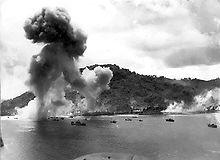Sankisan Maru
|
||||||||
|
||||||||
The Sankisan Maru ( Japanese 山鬼 山 丸 ) was a cargo ship that was sunk with explosive cargo on board during World War II .
history
The exact history or identity of the ship is not known. According to Vincenzo Paolillo, the cargo ship was built in the United States in 1920 and was still called Estero when it fell into the hands of the Japanese Navy in 1942 . Beth and Shaun Tierney also think it is possible that the ship came from Washington and was originally called Red Hook , but they also speculate that the freighter originally came from Japan. DD Todd & Construction Corp. will be the shipyard for the Red Hook . called in Tacoma , Washington. The ship could be called Commercial Traveler , Nelson Traveler (1936),Point Estero , Estero (1939) and finally Yamakisan Maru or Naruo Maru . Some sources name Harima Dockyard as the shipyard and the Kaburagi Kisen Line as the first user.
In any case, the Japanese Navy used the ship to transport weapons, aircraft parts, tractors, trucks, ammunition, etc. On February 17, 1944, the Sankisan Maru anchored near the west coast of the island of Uman in a lagoon that was then called Truk Lagoon 1990 but bears the name Chuuk Lagoon . A day later she was bombed there by a B-17 . The ship was shot at with machine guns from the escort aircraft. However, the hits were not enough to sink the Sankisan Maru .
The morning after these attacks, another B-17 squadron appeared as part of Operation Hailstone and launched an attack on the ship. The Sankisan Maru was hit by a torpedo , with the bridge and the rear cargo holds largely destroyed. The rest of the ship, which sank very quickly, dragged most of the crew with it into the depths. The Sankisan Maru , which was set on fire, sank so quickly that its cargo could no longer explode.
The wreck of the Sankisan Maru is about 350 meters off the coast. The demolished stern is at a depth of around 50 meters. A connection to the central nave is only given by scattered metal parts. A dud that was discovered in 1974 during salvage work in the first hold was detonated in the stern. The front part of the ship stands upright at a depth of about 30 meters on the seabed. The upper deck is therefore at a depth of around 18 meters, the mast tips reach up to around five meters below the surface of the water. In the vicinity of the hatch to the first hold of the wreck, which is densely overgrown with soft corals , sponges and mussels , are the remains of two trucks. In this hold itself there are still large quantities of grenades and artillery projectiles, some of which are still stored in their boxes. Some of this ammunition was later recovered and used to blast navigable passages into the coral reef that surrounds the lagoon. In the second and third hold, in addition to ammunition, there are aircraft parts and the remains of trucks. A twin machine gun and cannon are mounted on the foredeck.
literature
- Wiliam A. Brewer, Removal of Hazardous Materials from the Sankisan Maru in the Truk Lagoon: A Final Report , sn 1973
- Stephen C. Jameson, Toxic Effects of the Explosive Depth Charge Chemicals from the Ship Sankisan Maru on the Coral Reef Fish Dascyllus aruanus (L) , Micronesia (Guam) 11, 1975, pp. 109-113
- Vincenzo Paolillo, Sankisan Maru , in: Egidio Trainito (ed.), Adventure wreck diving. On the trail of sunken worlds , White Star Verlag, Wiesbaden 2009, ISBN 978-3-86726-120-3 , pp. 220-225
Individual evidence
- ↑ Vincenzo Paolillo, Sankisan Maru , in: Egidio Trainito (ed.), Adventure wreck diving. In the footsteps of sunken worlds , White Star Verlag, Wiesbaden 2009, ISBN 978-3-86726-120-3 , pp. 220–225, here p. 220
- ↑ Beth & Shaun Tierney, Diving the World , Footprints 2006, p. 333
- ↑ Michaelmcfadyenscuba.info after Dan E. Bailey, WWII Wrecks of the Kwajalein and Truk Lagoon and Klaus Lindemann, Sankisan Maru. Hailstorm over Truk Lagoon .
- ↑ So z. B. Idivenow.com .
Coordinates: 7 ° 17 '38.2 " N , 151 ° 51' 57.2" E
